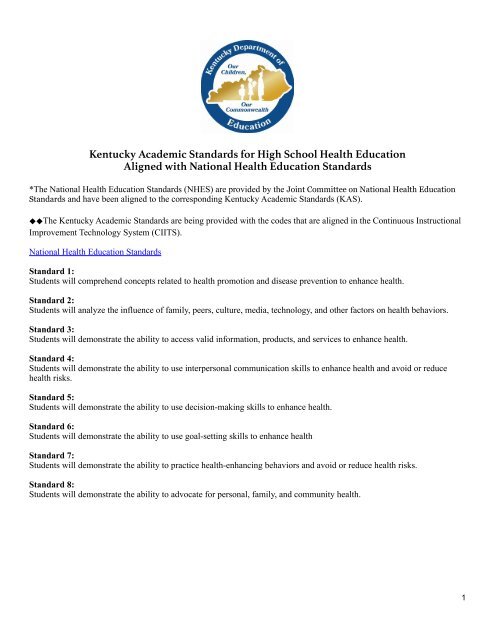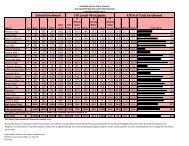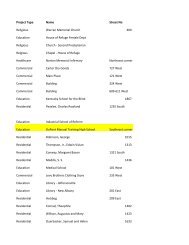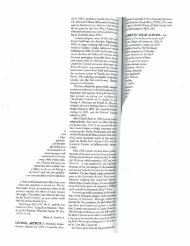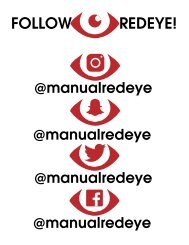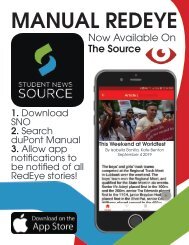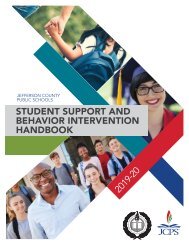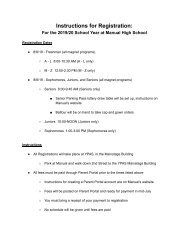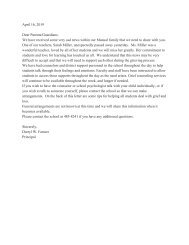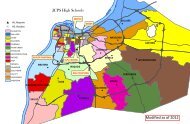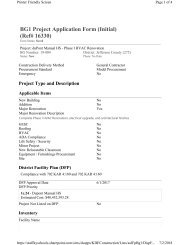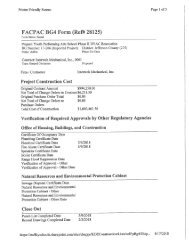High School Health KAS Aligned to NHES
You also want an ePaper? Increase the reach of your titles
YUMPU automatically turns print PDFs into web optimized ePapers that Google loves.
Kentucky Academic Standards for <strong>High</strong> <strong>School</strong> <strong>Health</strong> Education<br />
<strong>Aligned</strong> with National <strong>Health</strong> Education Standards<br />
*The National <strong>Health</strong> Education Standards (<strong>NHES</strong>) are provided by the Joint Committee on National <strong>Health</strong> Education<br />
Standards and have been aligned <strong>to</strong> the corresponding Kentucky Academic Standards (<strong>KAS</strong>).<br />
⬥⬥The Kentucky Academic Standards are being provided with the codes that are aligned in the Continuous Instructional<br />
Improvement Technology System (CIITS).<br />
National <strong>Health</strong> Education Standards<br />
Standard 1:<br />
Students will comprehend concepts related <strong>to</strong> health promotion and disease prevention <strong>to</strong> enhance health.<br />
Standard 2:<br />
Students will analyze the influence of family, peers, culture, media, technology, and other fac<strong>to</strong>rs on health behaviors.<br />
Standard 3:<br />
Students will demonstrate the ability <strong>to</strong> access valid information, products, and services <strong>to</strong> enhance health.<br />
Standard 4:<br />
Students will demonstrate the ability <strong>to</strong> use interpersonal communication skills <strong>to</strong> enhance health and avoid or reduce<br />
health risks.<br />
Standard 5:<br />
Students will demonstrate the ability <strong>to</strong> use decision-making skills <strong>to</strong> enhance health.<br />
Standard 6:<br />
Students will demonstrate the ability <strong>to</strong> use goal-setting skills <strong>to</strong> enhance health<br />
Standard 7:<br />
Students will demonstrate the ability <strong>to</strong> practice health-enhancing behaviors and avoid or reduce health risks.<br />
Standard 8:<br />
Students will demonstrate the ability <strong>to</strong> advocate for personal, family, and community health.<br />
! 1
1.PL-H-PW: Personal Wellness (<strong>Health</strong> Education)<br />
Kentucky Academic Standards<br />
<strong>High</strong> <strong>School</strong> (9-12)<br />
Big Idea:<br />
Wellness is maximum well-being, or <strong>to</strong>tal health. Personal Wellness is a combination of physical, mental,<br />
emotional, spiritual and social well-being. It involves making choices and decisions each day that promote<br />
an individual’s physical well-being, the prevention of illnesses and diseases, and the ability <strong>to</strong> remain,<br />
physically, mentally, spiritually, socially and emotionally healthy.<br />
Academic Expectations<br />
2.29 Students demonstrate skills that promote individual well-being and healthy family relationships.<br />
2.31 Students demonstrate the knowledge and skills they need <strong>to</strong> remain physically healthy and <strong>to</strong> accept responsibility<br />
for their own physical well-being.<br />
2.32 Students demonstrate strategies for becoming and remaining mentally and emotionally healthy.<br />
3.2 Students demonstrate the ability <strong>to</strong> maintain a healthy lifestyle.<br />
4.1 A. Students PL-H-PW-U: effectively Enduring use interpersonal Knowledge skills. – Understandings<br />
<strong>NHES</strong><br />
4.4 Students Students will demonstrate understand the that… ability <strong>to</strong> accept the rights and responsibilities for self and others.<br />
5.1 PL-H-PW-U-1:<br />
Students use critical thinking skills such as analyzing, prioritizing, categorizing, evaluating, and comparing <strong>to</strong> solve a<br />
variety 8<br />
individuals of problems have a in responsibility real-life situations. <strong>to</strong> advocate for personal, family and community health.<br />
5.4 Students use a decision-making process <strong>to</strong> make informed decisions among options.<br />
PL-H-PW-U-2:<br />
inter and intrapersonal communication skills are needed <strong>to</strong> enhance individual well-being and healthy 4<br />
relationships.<br />
PL-H-PW-U-3:<br />
physical, social, emotional and mental changes occur during adolescence and throughout life.<br />
PL-H-PW-U-4:<br />
decisions regarding sexuality have short and long term consequences and responsibilities.<br />
PL-H-PW-U-5:<br />
the environment, lifestyle, family his<strong>to</strong>ry, peers and other fac<strong>to</strong>rs impact physical, social, mental and<br />
emotional health.<br />
PL-H-PW-U-6:<br />
culture, values (e.g., individual, family and community) media and use of technology (e.g., television,<br />
computers, MP3 Players, electronic/arcade games) can influence personal behavioral choices.<br />
PL-H-PW-U-7:<br />
behavioral choices affect physical, mental, emotional and social well-being and can have positive or<br />
negative consequences on one’s health.<br />
PL-H-PW-U-8:<br />
positive health habits can help prevent injuries and spreading of diseases <strong>to</strong> self and others.<br />
PL-H-PW-U-9:<br />
self-management and coping strategies can enhance mental and emotional health.<br />
PL-H-PW-U-10:<br />
a variety of resources are available <strong>to</strong> inform, treat and counsel individuals with physical, mental, social<br />
and emotional health needs.<br />
1<br />
5<br />
1<br />
2<br />
1<br />
7<br />
7<br />
3<br />
! 2
B. PL-H-PW-S: Skills and Concepts – Personal and Physical <strong>Health</strong><br />
Students will understand…<br />
PL-H-PW-S-PPH1:<br />
understand the importance of assuming responsibility for personal health behaviors by:<br />
PL-H-PW-S-PPH1.a:<br />
predicting how decisions regarding health behaviors have consequences for self and others<br />
PL-H-PW-S-PPH1.b:<br />
explaining how body system functions can be maintained and improved (e.g., exercise, nutrition,<br />
safety)<br />
PL-H-PW-S-PPH1.c:<br />
explaining how decision-making relates <strong>to</strong> responsible sexual behavior (e.g., abstinence,<br />
preventing pregnancy, preventing HIV/STDs), impacts physical, mental and social well- being<br />
of an individual<br />
PL-H-PW-S-PPH2:<br />
apply goal-setting and decision-making skills in developing, implementing and evaluating a personal<br />
wellness plan<br />
PL-H-PW-S-PPH3:<br />
evaluate the effectiveness of communication methods for expressing accurate health information and<br />
ideas<br />
PL-H-PW-S-PPH4:<br />
evaluate how an individual’s behaviors and choices of diet, exercise and rest affect the body<br />
<strong>NHES</strong><br />
5, 7<br />
5<br />
7<br />
5<br />
5, 6<br />
3, 4<br />
7<br />
C. PL-H-PW-S-GD: Skills and Concepts – Growth and Development<br />
Students will…<br />
PL-H-PW-S-GD1:<br />
explain basic structures and functions of the reproductive system as it relates <strong>to</strong> the human life cycle<br />
(e.g., conception, birth, childhood, adolescence, adulthood)<br />
<strong>NHES</strong><br />
1<br />
D. PL-H-PW-S-SMEH: Skills and Concepts – Social, Mental and Emotional <strong>Health</strong><br />
Students will demonstrate social interaction skills by…<br />
PL-H-PW-S-SMEH1:<br />
demonstrate social interaction skills by:<br />
PL-H-PW-S-SMEH1.a:<br />
identifying and utilizing management techniques needed for dealing with intrapersonal and<br />
interpersonal relationships throughout life<br />
PL-H-PW-S-SMEH1.b:<br />
using and explaining the importance of effective social interaction skills (e.g., respect, selfadvocacy,<br />
cooperation, communication, identifying different perspectives and points of view,<br />
empathy, friendship)<br />
PL-H-PW-S-SMEH1.c:<br />
recommending and justifying effective strategies (e.g., problem solving, decision making,<br />
refusal skills, anger management, conflict resolution) for responding <strong>to</strong> stress, conflict, peer<br />
pressure and bullying<br />
<strong>NHES</strong><br />
4, 5, 6, 7<br />
4, 7<br />
4<br />
5<br />
! 3
PL-H-PW-S-SMEH1.d:<br />
identifying and explaining changes in roles, responsibilities and skills needed <strong>to</strong> effectively work<br />
in groups throughout life (e.g., setting realistic goals, time and task management, planning,<br />
decision- making process, perseverance)<br />
PL-H-PW-S-SMEH2:<br />
recommend and justify effective self-management and coping strategies (e.g., setting realistic goals,<br />
time, task and stress management, decision making, learning style preference, perseverance) for<br />
maintaining mental and emotional health<br />
PL-H-PW-S-SMEH3:<br />
demonstrate the ability <strong>to</strong> use various strategies when making decisions related <strong>to</strong> health needs and risks<br />
of young adults<br />
PL-H-PW-S-SMEH4:<br />
demonstrate refusal, negotiation and collaboration skills <strong>to</strong> use in avoiding potential harmful situations<br />
5, 6<br />
5, 6<br />
5, 7<br />
4<br />
E. PL-H-PW-S-FCH: Skills and Concepts – Family and Community <strong>Health</strong><br />
Students will…<br />
PL-H-PW-S-FCH1:<br />
access and use a variety of resources from home, school and community that provide valid health<br />
information<br />
PL-H-PW-S-FCH2:<br />
understand and analyze how personal, family and community health can be influenced and challenged<br />
by:<br />
PL-H-PW-S-FCH2.a:<br />
family traditions/values<br />
PL-H-PW-S-FCH2.b:<br />
peer pressure<br />
PL-H-PW-S-FCH2.c:<br />
technology and media messages<br />
PL-H-PW-S-FCH2.d:<br />
cultural beliefs and diversity<br />
PL-H-PW-S-FCH2.e:<br />
interrelationships between environmental fac<strong>to</strong>rs and community health<br />
PL-H-PW-S-FCH3:<br />
use print and non-print sources <strong>to</strong>:<br />
PL-H-PW-S-FCH3.a:<br />
analyze how the prevention and the control of health problems are influenced by research and<br />
medical advances<br />
PL-H-PW-S-FCH3.b:<br />
investigate the role of health care providers in disease prevention<br />
PL-H-PW-S-FCH3.c:<br />
analyze how public health policies and government regulations influence health promotion and<br />
disease prevention<br />
<strong>NHES</strong><br />
3<br />
2<br />
2<br />
2<br />
2<br />
2<br />
2<br />
3<br />
3<br />
3<br />
3<br />
! 4
F. PL-H-PW-S-DP: Skills and Concepts – Communicable, Non-Communicable and Chronic<br />
Diseases Prevention<br />
Students will…<br />
PL-H-PW-S-DP1:<br />
demonstrate an understanding of diseases by:<br />
PL-H-PW-S-DP1.a:<br />
describing symp<strong>to</strong>ms, causes, patterns of transmission, prevention and treatments of<br />
communicable diseases (colds, flu, mononucleosis, hepatitis, HIV/STD, tuberculosis)<br />
PL-H-PW-S-DP1.b:<br />
describing symp<strong>to</strong>ms, causes, patterns of transmission, prevention and treatments of noncommunicable<br />
diseases (cancer, cardiovascular disease, diabetes, obesity, asthma, emphysema)<br />
<strong>NHES</strong><br />
1<br />
1<br />
1<br />
! 5
PL-H-PW-S-DP2:<br />
explore family his<strong>to</strong>ry, environment, lifestyle and other risk fac<strong>to</strong>rs related <strong>to</strong> the cause or prevention of<br />
disease and other health problems<br />
PL-H-PW-S-DP3:<br />
demonstrate an understanding of how <strong>to</strong> maintain a healthy body by:<br />
PL-H-PW-S-DP3.a:<br />
analyzing the impact of personal health behaviors on the functioning of body systems 7<br />
1<br />
7<br />
PL-H-PW-S-DP3.b:<br />
analyzing how behavior can impact health maintenance and disease prevention during<br />
adolescence and adulthood<br />
7<br />
G. PL-H-PW-S-ATOD: Skills and Concepts – Alcohol, Tobacco and Other Drugs<br />
Students will…<br />
PL-H-PW-S-ATOD1:<br />
demonstrate an understanding of the use and misuse of alcohol, <strong>to</strong>bacco and other drugs by:<br />
PL-H-PW-S-ATOD1.a:<br />
distinguishing between legal (e.g., over the counter, prescription drugs) and illegal drugs (e.g.,<br />
inhalants, marijuana, stimulants, depressants) and describing how their usage affects the body<br />
systems<br />
PL-H-PW-S-ATOD1.b:<br />
predicting the immediate/long-term effects of alcohol, <strong>to</strong>bacco and illegal drug usage and<br />
analyzing the impact on an individual’s health<br />
PL-H-PW-S-ATOD1.c:<br />
recommending interventions (e.g., cease enabling activities), treatments (e.g., AA, outpatient<br />
therapy, group therapy) and other strategies (e.g., enhancing self esteem, building skills for<br />
success) as forms of help for negative behaviors or addictions (e.g., drug addictions, eating<br />
disorders)<br />
<strong>NHES</strong><br />
1<br />
1<br />
1<br />
1<br />
! 6
2.PL-H-N: Nutrition (<strong>Health</strong> Education)<br />
Big Idea:<br />
Proper nutrition is critical <strong>to</strong> good health. To maintain a healthy weight, good dietary habits and physical<br />
activity are essential. Nutritious foods are necessary for growth, development and maintenance of healthy<br />
bodies.<br />
Academic Expectations<br />
2.30 Students evaluate consumer products and services and make effective consumer decisions.<br />
2.31 Students demonstrate the knowledge and skills they need <strong>to</strong> remain physically healthy and <strong>to</strong> accept responsibility<br />
for their own physical well-being.<br />
3.2 Students demonstrate the ability <strong>to</strong> maintain a healthy lifestyle.<br />
3.5 Students will demonstrate self-control and self-discipline.<br />
5.1 Students use critical thinking skills such as analyzing, prioritizing, categorizing, evaluating, and comparing <strong>to</strong> solve a<br />
variety of problems in real-life situations.<br />
4. Students use a decision-making process <strong>to</strong> make informed decisions among options.<br />
A. PL-H-N-U: Enduring Knowledge – Understandings<br />
Students will understand that…<br />
PL-H-N-U-1:<br />
nutritional choices affect an individual’s physical, mental, emotional and social well-being.<br />
PL-H-N-U-2:<br />
nutrients have a role in the development of an individual’s health.<br />
PL-H-N-U-3:<br />
resources (e.g., Food Guide Pyramid, Dietary Guidelines for Americans, United States Department of<br />
Agriculture (USDA), National Dairy Council) are available <strong>to</strong> assist in making nutritional choices.<br />
PL-H-N-U-4:<br />
individuals, families and community values influence nutritional choices.<br />
<strong>NHES</strong><br />
5<br />
1<br />
3<br />
2<br />
B. PL-H-N-S: Skills and Concepts<br />
Students will…<br />
PL-H-N-S-1:<br />
create meal plans utilizing print and non-print resources (e.g., Food Guide Pyramid (FGP), Dietary<br />
Guidelines for Americans, United States Department of Agriculture (USDA), National Dairy council)<br />
PL-H-N-S-2:<br />
evaluate healthy nutritional practices (e.g., meal planning, food selection, reading labels, weight control,<br />
special nutritional needs) for a variety of dietary needs<br />
PL-H-N-S-3:<br />
analyze and evaluate the positive and negative impact of food selections on maintaining and promoting<br />
health<br />
PL-H-N-S-4:<br />
identify issues, problems and solutions related <strong>to</strong> extreme eating behaviors (overeating, obesity, anorexia,<br />
bulimia)<br />
PL-H-N-S-5:<br />
analyze fac<strong>to</strong>rs (e.g., geography, family, cultural background, convenience, cost, advertising, friends,<br />
personal taste) that influence healthy food choices<br />
<strong>NHES</strong><br />
3, 7<br />
7<br />
7<br />
7<br />
2<br />
! 7
PL-H-N-S-6:<br />
evaluate the role of nutrients and food sources in the growth and development of healthy bodies<br />
PL-H-N-S-7:<br />
evaluate nutritional resources from home, school and community that provide valid health information<br />
1,7<br />
3<br />
! 8
3.PL-H-S: Safety (<strong>Health</strong> Education)<br />
Big Idea:<br />
Accidents are a major cause of injury and death <strong>to</strong> children and adolescents. Unintentional injuries<br />
involving mo<strong>to</strong>r vehicles, falls, drowning, fires, firearms, and poisons can occur at home, school and work.<br />
Safe behavior protects a person from danger and lessens the effects of harmful situations.<br />
Academic Expectations<br />
2.31 Students demonstrate the knowledge and skills they need <strong>to</strong> remain physically healthy and <strong>to</strong> accept responsibility for<br />
their own physical well-being<br />
2.33 Students demonstrate the skills <strong>to</strong> evaluate and use services and resources available in their community<br />
3.2 Students will demonstrate the ability <strong>to</strong> maintain a healthy lifestyle<br />
4.3 Students individually demonstrate consistent, responsive and caring behavior<br />
4.4 Students demonstrate the ability <strong>to</strong> accept the rights and responsibilities for self and others<br />
5.1 Students use skills such as analyzing, prioritizing, categorizing, evaluating and comparing <strong>to</strong><br />
solve a variety of problems in real-life situations<br />
5.4 Students use a decision-making process <strong>to</strong> make informed decisions among-options<br />
A. PL-H-S-U: Enduring Knowledge – Understandings<br />
Students will understand that…<br />
PL-H-S-U-1:<br />
safety practices and procedures help <strong>to</strong> prevent injuries and provide a safe environment.<br />
PL-H-S-U-2:<br />
community, state, federal and international resources are available <strong>to</strong> assist in hazardous situations.<br />
PL-H-S-U-3:<br />
proper procedures must be used in emergency situations.<br />
<strong>NHES</strong><br />
1<br />
3<br />
1<br />
B. PL-H-S-S: Skills and Concepts<br />
Students will…<br />
PL-H-S-S-1:<br />
analyze how responsible use of machinery and mo<strong>to</strong>rized vehicles (e.g., all-terrain vehicle, mo<strong>to</strong>rcycle,<br />
au<strong>to</strong>mobile, personal watercraft) and firearms reduce the risk of accidents and save lives<br />
PL-H-S-S-2:<br />
identify and describe potential hazards in home and schools and explain how <strong>to</strong> prevent injuries<br />
PL-H-S-S-3:<br />
identify components of safety needed in developing a personal plan for emergency situations (e.g.,<br />
weather, fire, <strong>to</strong>rnado, lock down) at home or school<br />
PL-H-S-S-4:<br />
demonstrate proper first-aid procedures (e.g., CPR/rescue breathing) for responding <strong>to</strong> emergency<br />
situations (e.g., falls, drowning, choking, bleeding, shock, poisons, burns, temperature-related<br />
emergencies, allergic reactions, broken bones, overdose, heart attacks, seizures) and explain how they<br />
help reduce the severity of injuries and save lives<br />
PL-H-S-S-5:<br />
demonstrate refusal, negotiation and collaboration skills needed <strong>to</strong> avoid potentially harmful situations<br />
<strong>NHES</strong><br />
7<br />
1<br />
1<br />
7<br />
4<br />
! 9
PL-H-S-S-6:<br />
identify and access the available local, state, federal and international health and safety agencies (e.g.,<br />
World <strong>Health</strong> Organization, Peace Corp, Center for Disease Control and Prevention (CDC), Armed<br />
Forces) and explain the services they provide<br />
PL-H-S-S-7:<br />
use reliable safety resources and guidelines <strong>to</strong> help in avoiding injuries and dangerous situations (e.g.,<br />
internet use, vehicles, firearms, watercraft)<br />
PL-H-S-S-8:<br />
demonstrate communications skills needed in emergency situations<br />
PL-H-S-S-9:<br />
explain safety practices needed when assuming responsibilities (e.g., child care, house-sitting, elderly<br />
care, pet care) in caring for animals, property and other individuals<br />
3<br />
3, 7<br />
4<br />
1<br />
*KY Program of Studies was aligned <strong>to</strong> National <strong>Health</strong> Education Standards by Renee White, Ph.D., Coordinated <strong>School</strong> <strong>Health</strong> Team, Division of<br />
Program Standards, Kentucky Department of Education, August 2011. The National <strong>Health</strong> Education Standards can be found at http://<br />
www.cdc.gov/<strong>Health</strong>yYouth/SHER/standards/<br />
! 10


